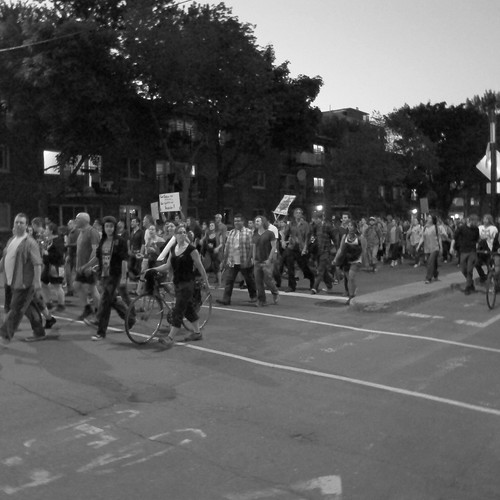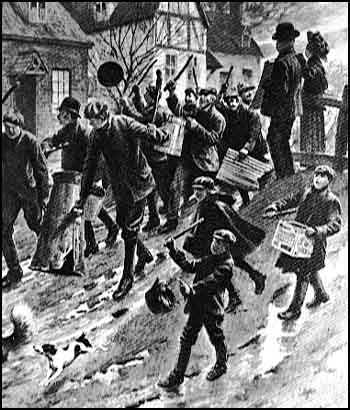 |
| Flickr xddorox |
 |
| G. Desplat, Charivaris en Gascogne.1982.Darby's Diary |
Brian Palmer outlines the practice of charivari in its earlier European forms in a 1978 article in Labour/Le Travail, "Discordant Music: Charivaris and Whitecapping in Nineteenth-Century North America." Palmer wrote that, "the demonstration was most often initiated under the cover of darkness, a party gathering at the house of the offender to beat pans and drums, shoot muskets, and blow the ubiquitous horn, which butchers often rented out for the occasion. Sometimes the guilty party was seized, perhaps to be roughly seated on a donkey, facing backwards, and then paraded through the streets, passers-by loudly informed of his/her transgression. (p.9) The ritual was "most often used to expose to the collective wrath of the community adulterous relationships, cuckolded husbands, wife and husband beaters, unwed mothers, and partners in unnatural marriage."
 Palmer notes that in England, the term "rough music" was applied to the ritual, and that if warnings for bad behaviour were not heeded, the procession would set out for the house of the deviant. "Under the cover of darkness a procession formed, headed by two men with huge cow-horns, followed by an individual with a large old fish-kettle around his neck, representing the trumpeters and big drum of a serious parade. The legendary neo-marxist historian E.P. Thompson described the procession as, "a motley assembly with hand-bells, gongs, cow-horns, whistles, tin kettles, rattles, bones, frying-pans, everything in short from which more and rougher music than ordinary could be extracted.'' Palmer notes that the different forms of charivari in early-modern Europe were "a pre-political form of class action" used for social control. (p.15).
Palmer notes that in England, the term "rough music" was applied to the ritual, and that if warnings for bad behaviour were not heeded, the procession would set out for the house of the deviant. "Under the cover of darkness a procession formed, headed by two men with huge cow-horns, followed by an individual with a large old fish-kettle around his neck, representing the trumpeters and big drum of a serious parade. The legendary neo-marxist historian E.P. Thompson described the procession as, "a motley assembly with hand-bells, gongs, cow-horns, whistles, tin kettles, rattles, bones, frying-pans, everything in short from which more and rougher music than ordinary could be extracted.'' Palmer notes that the different forms of charivari in early-modern Europe were "a pre-political form of class action" used for social control. (p.15).In North America, the charivari was first prominent in Lower Canada, Lousiana and Alabama (Palmer, p.17) At times the practice could manifest in racist actions where citizens felt racial boundaries had been overstepped. On occasion the rite was used as a form of political protest, but Palmer argues this was rare. Palmer notes that around 1890, North American charivari practice died down, replaced in part by white-capping, or vigilante justice against moral offenses.
Allan Greer disagreed with Palmer on the importance of charivari as a mode of political protest. In his 1990 Social History article "From folklore to revolution: charivaris and the Lower Canadian rebellion of 1837", he notes that the rebellion changed the charivari procession from its traditional role of social protest to more explicit political purposes. Prior to the rebellion, charivaris were used specifically against marriages which were considered ill-matched. Yet during the failed uprising of the Patriotes, the charivaris could take a aggressive stance towards local Loyalist officials.
Greer cites the case of one Lieutenant Dudley Flowers of St Valentin, whose house was subject to a particularly violent form of charivari, where the Patriots sought his resignation. Flowers wrote in 1837,
On the following day (Sunday) about seven in the evening, some sixty or seventy individuals attacked my house a third time in the same manner and with the same threats as on the former occasions but if possible with much more violence, beating kettles and pans, blowing horns, calling me a rebel, saying it would be the last time they would come as they would finish me in half an hour. They had in a short time with stones and other missiles broken in part of the roof of my house and boasted that it would soon be demolished. Fearing that such must inevitably be the case, I opened the door and told them that if four or five of their party would come in and give their names I would give them up my commission. (Greer, p.38)
 |
| Flickr: alexsnaps |
No comments:
Post a Comment